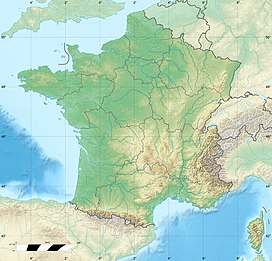
Back Mont Ventoux Afrikaans Mont Ventoux ALS Ventor AN جبل مونت ڤينتوكس ARZ Ventor Breton Ventor Catalan Mont Ventoux (bukid sa Pransiya) CEB Mont Ventoux Czech Mont Ventoux Welsh Mont Ventoux Danish
| Mont Ventoux | |
|---|---|
 South side of the summit of Mont Ventoux | |
| Highest point | |
| Elevation | 1,910 m (6,270 ft) |
| Prominence | 1,148 m (3,766 ft)[1] |
| Coordinates | 44°10′28″N 5°16′44″E / 44.17444°N 5.27889°E |
| Geography | |
Vaucluse, France | |
| Parent range | periphery of the Alps |
| Climbing | |
| First ascent | Prior to Jean Buridan; probably ancient |
| Easiest route | Hike |
| Mont Ventoux | |
|---|---|
 North side of the summit of Mont Ventoux | |
| Elevation | 1,910 m (6,266 ft) |
| Traversed by | road |
| Location | |
| Range | Free-standing on the western periphery of the Alps |
| Coordinates | 44°10′28″N 5°16′44″E / 44.17444°N 5.27889°E |
Mont Ventoux (French: [mɔ̃ vɑ̃tu]; Provençal: Ventor [venˈtu]) is a mountain in the Provence region of southern France, located some 20 km (12 miles) northeast of Carpentras, Vaucluse. On the north side, the mountain borders the department of Drôme. At 1,910 m (6,270 ft), it is the highest mountain in the region and has been nicknamed the "Beast of Provence",[2] the "Giant of Provence",[3][4] or "The Bald Mountain".[4] It has gained fame through its inclusion in the Tour de France cycling race;[4] in 2009 it was the scene of the first penultimate-day mountain top finish in the Tour de France, with Alberto Contador sealing his yellow jersey.[citation needed]
As the name suggests (venteux means windy in French), it can get windy at the summit, especially with the mistral; wind speeds as high as 320 km/h (200 mph) have been recorded. The wind blows at over 90 km/h (56 mph) for 240 days a year. The road over the mountain is often closed due to high winds, especially the col des tempêtes ("storm pass") just before the summit, which is known for its strong winds. In the 10th century, the names Mons Ventosus and Mons Ventorius appear.[citation needed]
Mont Ventoux, although geologically part of the Alps, is often considered to be separate from them, due to the lack of mountains of a similar height nearby. It stands alone to the north of the Luberon range, separated by the Monts de Vaucluse, and just to the east of the Dentelles de Montmirail, its foothills. The top of the mountain is bare limestone without vegetation or trees, which makes the mountain's barren peak appear from a distance to be snow-capped all year round (its snow cover actually only lasts from December to April). Its isolated position overlooking the valley of the Rhône ensures that it dominates the entire region and can be seen from a long distance away on a clear day.[citation needed]
- ^ "Mont Ventoux". Peakbagger.com. Retrieved 2010-07-04.
- ^ "Ascending the "Beast"". 17 July 2013. Retrieved 5 March 2014.
- ^ Maddock, David (13 July 2013). "Taking on Mont Ventoux: The Giant of Provence that stands squarely in front of Britain's Chris Froome this weekend". Mirror. Retrieved 5 March 2014.
- ^ a b c "Mont Ventoux". More than 21 bends. Archived from the original on 6 December 2019. Retrieved 5 March 2014.
© MMXXIII Rich X Search. We shall prevail. All rights reserved. Rich X Search

